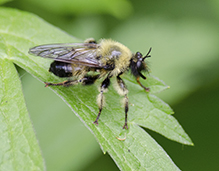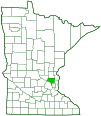bee-mimic robber fly
(Laphria sacrator)
Conservation • Description • Habitat • Biology • Distribution • Taxonomy
Conservation Status |
|
|||||||
| IUCN Red List | not listed |
|||||||
| NatureServe | NNR - Unranked |
|||||||
| Minnesota | not listed |
|||||||
Description |
||
With 7,003 species in 530 genera worldwide, robber flies are one of the largest and most abundant families of insects alive today. Bee-mimic robber flies, as their name suggests, resemble bees. There are 240 species of bee-mimic robber flies, 62 species in North America north of Mexico. Laphria sacrator is a short, robust, medium-sized, bee-mimic robber fly . It has a stout thorax and a short abdomen, both partially covered with long yellow hairs making it resemble a bumble bee. It is one of the hairiest of the bee-mimic robber flies. Adults are ⅝″ to 1″ long. The thorax is stout, bluish-black, and densely covered with long yellow hairs. The hairs at the upper middle of the thorax are sparse, letting the ground color show through. The abdomen is black, relatively short, and bee-like. The first three segments are covered with long yellow hairs. On the female most the fourth segment is also covered with yellow hairs. The remaining segments are covered with long black hairs. The forehead (frons) is short. The upper face has long, black, erect hairs and short, dirty yellow hairs that lie flat. There is a cluster of forward-directed bristles (a “beard”) on the lower part of the face. The beard on males is entirely black. On females there are yellow hairs at the upper margin of the beard behind the top of the eye. The hairs below the sucking mouth part (proboscis) are black. There are two large compound eyes and three small simple eyes (ocelli). The compound eyes extend above the level of the top of the head (vertex), making the head appear hollowed out between the eyes when viewed from the front. The ocelli are arranged in a triangle on a prominent rounded projection (tubercle) in the middle of the head between the compound eyes. The antennae have 3 segments. The third segment is elongated and is not subdivided by rings. The legs are stout and spiny. The fourth section (tibia) of the front and middle legs are covered with long yellow hairs. The last segment of the foot (tarsus) has 2 pads. |
||
Size |
||
Total length: ⅝″ to 1″ |
||
Similar Species |
||
Habitat |
||
Woodlands, shrubby woodland edges adjacent to a grassland. |
||
Biology |
||
Season |
||
June through July and possibly later |
||
Behavior |
||
|
||
Life Cycle |
||
|
||
Larva Food |
||
|
||
Adult Food |
||
Flying insects, including bees, wasps, beetles, and other robber flies |
||
Distribution |
||||
|
Sources |
|||
| 7/5/2017 | ||||
Occurrence |
||||
Fairly common in northeastern and north-central United States |
||||
Taxonomy |
|||
Order |
Diptera (flies) | ||
Suborder |
Brachycera | ||
Infraorder |
Muscomorpha | ||
Superfamily |
Asiloidea | ||
Family |
Asilidae (robber flies) | ||
Subfamily |
Laphriinae | ||
Tribe |
Laphriini | ||
Genus |
Laphria (bee-mimic robber flies) | ||
Synonyms |
|||
|
|||
Common Names |
|||
Few of the North American Laphria species have a common name. The common name for the genus is bee-mimic robber fly, and will be used here for convenience. |
|||
Glossary
Frons
The upper part of an insect’s face, roughly corresponding to the forehead.
Ocellus
Simple eye; an eye with a single lens. Plural: ocelli.
Proboscis
The protruding, tubular mouthpart of a sucking insect.
Tarsus
On insects, the last two to five subdivisions of the leg, attached to the tibia; the foot. On spiders, the last segment of the leg. Plural: tarsi.
Tibia
The fourth segment of an insect leg, after the femur and before the tarsus (foot).
Vertex
The upper surface of an insect’s head.
Visitor Photos |
|||||
Share your photo of this insect. |
|||||
| This button not working for you? Simply email us at info@MinnesotaSeasons.com. Attach one or more photos and, if you like, a caption. |
|||||
Christa Rittberg |
|||||
 |
|||||
MinnesotaSeasons.com Photos |
|||||
|
|||||

Slideshows |
||

Visitor Videos |
|||
Share your video of this insect. |
|||
| This button not working for you? Simply email us at info@MinnesotaSeasons.com. Attach a video, a YouTube link, or a cloud storage link. |
|||
Other Videos |
|||

Visitor Sightings |
|||||
Report a sighting of this insect. |
|||||
| This button not working for you? Simply email us at info@MinnesotaSeasons.com. Be sure to include a location. |
|||||
|
|||||
MinnesotaSeasons.com Sightings |
|||||
|
|||||

Created 7/5/2017
Last Updated:
